|
|
Posted By Admin,
Monday, June 12, 2023
|
Jan Takes the Wheel
By Web Editor
January 28, 2016
Every time I go through Sara's garden I see new vistas with mind-boggling color and texture
Our posts have always had their inspiration in Sara's garden. The concept of 'form and foliage' comes from her particular gardening focus. Jan attempts to capture this concept and as she has become more familiar with both the garden and her craft, she has had more of a tendency to go rogue and resist direction. Thus, we bring you some of her favorite images, unrestrained by Sara's prejudices or guidance. Her comments follow:
Every photographer interprets light and color in their own way, and photographers develop a style or a 'way of seeing' that they present in their photographs. Sara wants the photographs to 'look real', i.e. the way SHE sees the scene. My reality is not always the same as hers.
Agave 'Blue Glow' beginning to flower
The phenomenon of 'digital darkroom' technology provides so many tempting opportunities to play with images and take them beyond what the eye sees. The Agave above is a good example, tuned up with Trey Ratcliffe's Aurora HDR (Macphun) and Adobe Lightroom software.
Senecio 'Staghorn', Pinus contorta 'Spaan's Dwarf', Spirea 'Goldmound', garden photography
I'm always fascinated by color repetition, which leads the viewer's eye through the scene.
One of the photographers who has inspired me is Dewitt Jones. He doesn't go out capturing images, he waits for the images to capture him. The above shot caught me due to the wonderful repetition of the steely blues in the Mexican pebbles, the succulent, the copper top of the lamp and the spruce in the distance, all complemented by the vivid red and green.
Cryptomeria japonica 'Elegans Compacta', garden photography
This is an exquisite plant with soft colors, enhanced by the bejeweling water droplets.
Close-up photography is challenging, because composing an image with the right "depth of field" (how sharp the image is throughout) is very challenging. In this case, I want to capture the delicate shape and coloration of the foliage while keeping it in the context of the overall characteristic of the plant: an explosion of clouds of needles in shades of burgundy, mauve and pink. I strive to have just enough background to give context without overpowering the delicate subject.
When I take close-ups of plants, I am aware of the life that exists in a garden
Our objective on this day was to photograph yellows and blues, both in landscape shots and close ups. I am always attracted to spider webs, because they demonstrate that the garden is teeming with life, much of it hidden. This ladder-like structure is particularly distinctive.
Cedrus atlantica 'Glauca Pendula', conifers, garden photography
I love the structure of the blue Atlas cedar, but it was the combination of colors and shapes on the ground that caught my eye
I concentrate on our focus, which is woody foliage plants, but I can't control how my eye is drawn to other aspects of the garden. Just as with the spider web, the garden is home to many other forms of life, which ebb and flow with the seasons. The cedar's bristly, blue needles interact with the fragile mushroom and the rusty leaves to create a completely different perspective. Dewitt Jones has always counseled 'the first image that you see may not be the one that is most distinctive. You need to move around and look at the subject from different perspectives, and maybe change your lens. In doing that, you may discover something more beautiful than you thought you saw originally.'
Brahea armata, garden photography
Sara wanted a photo of her favorite palm tree. She was startled when this is what I produced.
Sara expected a shot of the graceful blue-gray fronds that fan out over the succulent garden. When I went out to shoot the plant, I found myself fascinated with the yellow teeth along the stems and the fibrous trunk. I ignored the fronds and focused on what spoke to me. It took her a while to understand what I saw. This image now hangs in her home, because the plant took on an additional dimension for her once she understood my perspective.
garden photography, Brahea armata
The Mexican blue fan palm provides a fantastic opportunity for a classic graphic image.
I threw Sara a bone and focused on the leaves. Once again, I produced a different image than the one she expected. I was struck by the color and the steely structure. The pleats emanate from the stem dynamically, creating a sense of movement that I could not ignore. The imperfections make it more interesting.
Mangave 'Macho Mocha', succulents, foliage gardening, garden photography
I'm fascinated by this plant; it's an amazing combination of reptilian marking and metallic texture, complemented by beautiful colors
I'm really drawn to agaves because of their structure and their prehistoric aspects. This agave hybrid is particularly compelling, and I love the explosion of the lime green from the center to the mottled leaves. If you're any good at photography, you've learned early that you need to go beyond what first captured your attention and seek alternative views.
Mangave 'Macho Mocha', succulents, foliage gardening, garden photography
Complementary colors and contrasting textures make for a pleasing combination
The colors of the mangave are echoed in the colors of the restio, giving the image integrity and continuity. The image is strengthened by the contrast between the broad, strappy leaves of the mangave and the wispy, threadlike stems of the restio, capped with the burgundy seedheads.
Phormium 'Dusky Chief', garden photography
Sometimes I just can't help myself.
I recently got an 'infrared kit'. I love the way shooting in infrared reveals aspects of the image that conventional photography does not. If the palm shot nonplussed Sara, what do you think this one will do?
Stay tuned....
Tags:
Learn
Permalink
|
|
|
Posted By Admin,
Monday, June 12, 2023
|
The ACS gets a Shout-Out from the American Horticultural Society
By Web Editor
November 8, 2020
The conifer collection at The Oregon Garden. Photo by Janice LeCocq
The Oregon Garden's conifer collection has been one of the ACS's most successful Reference Gardens. ACS volunteers, led by Western Region member Doug Wilson, have worked in tandem with the Garden's staff and management to envision, plan, plant and care for a stunning variety of conifers and companion plants. The mounded beds in the conifer garden are replete with not just a dizzying number of conifer specimens, but also a wide variety of companion plants. Japanese maples, beeches, Japanese snowbell trees, peonies, ornamental grasses, dogwoods, heathers and heaths are only some of the plants used with conifers to produce painterly combinations of foliage that rival any floral display. The mix of evergreens and deciduous trees and shrubs, varied shapes, sizes and textures is amongst the best we've seen at any public garden.
The American Horticultural Society's latest monthly newsletter carries an article about The Oregon Garden, calling the conifer collection the Garden's 'crown jewel' and noting that there are 3,000 taxa in this one acre area!

We count over 30 taxa in this shot! Photo by Janice LeCocq
The pandemic has made travel challenging, but this is one to put on your list for when normal life resumes. The Oregon Garden Resort is on the property and guests are able to enter the garden at any hour. Wandering the paths of the conifer garden with glass of wine or cup of coffee in hand is a lovely way to experience this marvelous collection. And don't forget your camera!
The Oregon Garden
Tags:
Learn
Permalink
|
|
|
Posted By Admin,
Monday, June 12, 2023
|
The Sequel to the Ever-Popular Summer: Autumn!
By Web Editor
October 27, 2020
Summer is sedate, but Autumn is outrageous!
Fall Gardening
Back in July, as you may recall, our anonymous film director manqué wrote a piece likening his gardening to that of overseeing ensemble actors on a set, along with managing lighting, placement and interaction. Well, he's back with a sequel, and like so many sequels, this one is more dramatic than the original! While is it tempting to think that the garden director's job is easier than that performed on a Hollywood set, Hollywood generally doesn't have death, disease or pathogens impair progress, nor does it have the peculiar problem specific to garden design, wherein the subjects outgrow their spots. Imagine if a movie director had to get his project finished before the star player got (literally) too big for his britches. (Full cast, from left to right: Larix kaempferi 'Diana', Chamaecyparis pisifera 'Nana', Acer palmatum 'Ueno yatsubusa', and, to its right, Acer palmatum 'Pixie', with Pinus parviflora 'Ogon janome' in between. Behind is a blue form of Abies concolor, not a named cultivar but selected from the field. On the far right is Acer x 'Trompenburg', aka Acer palmatum 'Trompenburg'.)
In the photo above, the three maples, which were reasonably content to play as part of the ensemble, without claiming star billing, seem to have gotten Hollywood-sized egos as their autumn performance came around. The assorted conifers are all evergreens, and are steadfastly continuing on in character, while the maples apparently got fat new contracts and stars on their dressing rooms. What they don't appreciate is that the deep, rich, cool blues and greens allow the yellow and red to blaze. What is life - or beauty - without contrast?
Now the entire ensemble has autumn fever
Evergreens and Fall Color
In this shot we see that the director has changed the plot of the sequel to an inferno! Dogwoods, maples, grasses and more have all changed costumes to portray fall's fiery colors. Even the grass, stubbornly remaining green, gets an autumnal sprinkling. The evergreen conifers, again, reliably playing their parts, provide the contrast necessary to really ignite the deciduous characters. The blue spruce is particularly useful, as blue and orange are color-wheel opposites and opposite pairings produce the most dramatic combinations. The same is true of red and green. (Full cast, from left to right: Cornus florida 'Appalachian Spring' - note that the yellow behind it is Acer x 'White Tigress, which is a cross between A. davidii and A. tegmentosum, Abies procera 'Glauca Prostrata', Imperata cylindrica var. koenigii 'Red Baron', Ophiopogon planiscapus 'Kokuryu', Larix kaemferi 'Pendula, wrapped around Picea pungens 'St. Mary's Broom', Acer palmatum 'Pixie', Acer palmatum Ueno yatsubusa', Acer palmatum 'Koto no ito' (a very small specimen to the right of the lantern), Chamaecyparis pisifera 'Nana'. Two tall conifers in the background: Picea omorika 'Pendula' and the same blue Abies concolor. Far right in far background is Acer japonicum 'Vitifolium')
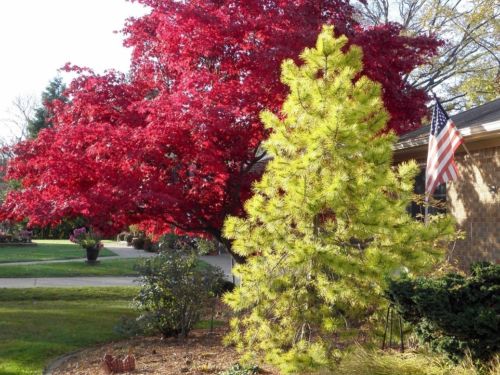 Finally, a conifer decides it wants to play with hot colors, too
Not all conifers are cool dudes in their blues and greens. Some, like the pine above, glow golden in autumn's soft light, and make a stunning pairing with a Japanese maple costumed in scarlet. We'd love to be able to call it a 'scarlet starlet' but this tree is mature and handsome; a diva, not an ingenue. Turns out that it was 'discovered talent', picked up at a clearance sale with no tag. With special coaching, our director teased its roots and gave it the confidence to play a leading role! The conifer is one that we have almost all coveted but have not all succeeded with: Pinus contorta var. latifolia 'Chief Joseph'. It lurks in the background for much of the year, playing an understated role of medium green. Come cold weather it reveals its true talents and struts its sunny yellow. This one may well be the largest specimen east of the MIssissippi, as it was planted over 25 years ago. Imagine whta it looks like when male cardinals cavort amongst its needled.
Did you think that this much color could be had without flowers? And neither one of these plants requires deadheading or fertilizing.
Japanese maple and conifer with a different supporting cast. Photo by Janice LeCocq
Our director gardens in the upper midwest, but lest you think that this only plays in Peoria, see the above shot of a garden in northern California. The stars (an Acer palmatum 'Ruby Lace' and a Chamaecyparis lawsoniana 'Barry's Silver') can take the show on the road and play with the local talent to round out the cast, in this case a couple of olive trees and some Helictotrichon sempervirens. Different cast, same powerful production.
The Oregon Garden welcomes autumn drama! Photo by Janice LeCocq
For much of the year at this Silverton conifer collection, the conifers' performance is center stage, playing majestically in full-needled glory. But autumn's colors make the conifers play off the season's stars, in this case a flaming heather. Once again, note how the blue of the conifer really sets off the hot tones. Not all actors can be divas in all productions! We need a chorus, too.
Can't grow Japanese maples? There are other ways to get seasonal color. Photo by Janice LeCocq
Ideas for Fall Garden Color
If you live in the mid-Atlantic, Southeast, lower midwest or Pacific Northwest, Japanese maples will play in your production very happily. Those in adjacent areas can also often find specific actors who will oblige. But if you find that Acer palmatum is a flop in your garden, there are many other plants that can provide autumn color to contrast with your conifers. The Aloe above is locked in a passionate embrace with a juniper, and come autumn, always blushes at the juniper's advances. If you are in a cold zone, try Rhus or Spirea, Fothergilla or Viburnum. For those of us in Mediterranean climates, we can often 'borrow' stars from other studios, successfully growing Nyssa, Viburnum, Cotinus and +other than palmatum. The mountain west has its aspens, and Texas and the southwest boast a long list of native species that color dramatically when the days shorten, such as oaks, maples, mesquite and cypress. Look at your garden as we approach the end of Daylight Savings Time. Could it use a little star power? Maybe even a star couple: a blue or green conifer and an orange or red deciduous co-star!
That's a wrap!
Tags:
Learn
Permalink
|
|
|
Posted By Admin,
Monday, June 12, 2023
|
Stylish Simplicity - Paul and Paula's Garden
By Web Editor
April 28, 2013
Because of our passion for plants, we tend to focus on gardens that feature collections of specimens and stretch our imaginations devising pleasing and provocative combinations of colors, textures and shapes. Sometimes, however, the strongest statements come from the deft use of massed plantings and fundamental color and design principles. Paul and Paula's garden is a beautiful example of keeping it simple without sacrificing interest or sophistication. And in best form and foliage fashion, this garden shines through the fall and winter months as well as spring and summer!

purple leaved plants, color wheel combinations, purple evergreen plants
Despite the unfettered design, much care went into its conception and the selection of the plantings. Paula, who has an artist's training and sensibilities, chose the Loropetalum to border the path because she wanted to echo the tones of the brick with a complementary plant that was appropriately sized and attractive year-round. The decision to use deep reddish-purple against the brick was daring; most of us think 'red' when we think of brick, but the purple brings out the rosy tones. Also, most of us would have not been able to resist the urge to plant a jumble of different colors and textures; Paula's confidence in the essential design principles of repetition, scale and color harmony allowed her to resist that temptation!
Chamaecyparis obtusa, purple-leaved foliage, succulents
The distinctive purple of the Loropetalums is repeated in the carpet of Sedum 'Voodoo' around the foundation plantings of Chamaecyparis obtusa cultivars. This is horticultural 'color blocking' with rich, deep tones, and the repetition of the purple and green makes for a unified design. While respecting the formal lines of the brick house, these plantings also soften, enrich and complement it.
conifers, foliage plants, evergreen plants
On the side of the house, Paula used more mass plantings of evergreen shrubbery and chose two Cedrus libani var. atlantica (Atlantic cedars) as focal points. Those of you that read our post on Color Scheming will recognize that the purple/brick combination represents an analogous color pair, while the blue/brick is a complementary combination. That's why the cedars are edgier and demand more attention, and their skirt of shrubs is correspondingly subdued. The brick borrows tones from the adjacent plants, appearing rosier next to the purple-leaved Loropetalum and more orange next to the blue cedar.
Arbutus 'Marina', Loropetalum 'Purple Pixie'
Note the crisp edging and the clean lines of the multi-trunked trees (an Acer palmatum cultivar on the left, Arbutus 'Marina on the right). The planted are sited to 'let the shapes show' and their structure is as important as their colors and textures. In this bed the Loropetalums function as punctuation and connect it to the walkway and foundation plantings.
purple foliage plants
The rich jewel tones are repeated throughout the garden, with different plant combinations. The Japanese maples and ferns adorn the wooded side yard that is shaded by towering Atlantic cedars and oaks. By varying the plant materials but sticking to the color scheme, the different areas of the garden are connected and unified. The overall sensation is one of serenity; the simplicity of the design is in itself relaxing and the choice of colors reinforces the calmness.
Japanese maples, gardening with rocks
We like to say that sometimes the best plant for a particular spot is a stone...and Paula repeats the blue of the cedars with specimen stones. The combination of purple, icy blue and rich green now has many textural components that continue to be unified by color and simplicity. The stones also echo the structural lines of the woody plants and provide interest throughout the year.
foliage garden, evergreen foliage
The latest project is a rock garden at the back of the property with newly planted roses, succulents and a few specimen conifers, anchored by a pair of mature Corylus avellana 'Contorta' (Harry Lauder's walking stick, one of which can be seen on the right side of the photo). Here purple gives way to accents of brilliant gold and chartreuse, and when the plantings spill over the rocks this will be the spot in the garden where the formality eases a bit, as it is away from the house and can set its own tone.
conifers, foliage plants, golden foliage
We look forward to visiting the garden again when the plantings around the rocks have matured and provided the cohesiveness that Paula intends. Although this spot is across the back lawn from the house, the brilliant Caucasian fir 'Golden Spreader' shines like a beacon and calls the eye. Another design principle that Paula has employed: light, bright colors project, dark colors recede. The strategic placement of one golden plant draws attention to the entire bed.
The final component of the garden design is a serene water feature
While Paula works with plant selection and design, Paul tends the Koi pond that not only provides pleasing sound and interest, but reflects the branches of the specimen trees. We came away from Paul and Paula's garden feeling relaxed and as if our blood pressure had dropped a notch. Isn't that a wonderful gift for a garden to bestow?
Tags:
Learn
Permalink
|
|
|
Posted By Admin,
Monday, June 12, 2023
|
Taxodium Update by David Creech
By Jeff Harvey
March 14, 2022
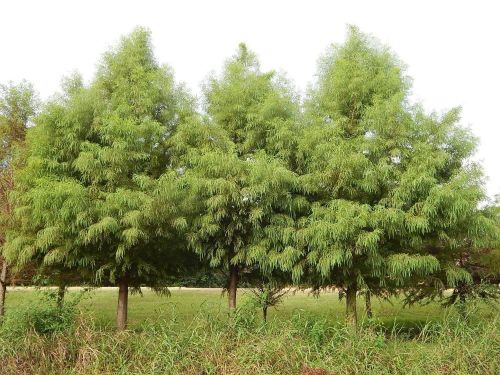
Taxodium Ianana t406
Taxodium at SFA Gardens – A 2022 Update
SFA Gardens remains a valued resource at Stephen F. Austin State University (SFA). This 128-acre garden in the Pineywoods of East Texas got its start in 1985 and includes a wide range of rarely encountered woody and herbaceous species. This is a collector’s garden, and one of our most intense collections is Taxodium.
The precise nomenclature for Taxodium remains a matter of some debate. Still considered by many as three species (T. distichum, T. ascendens, and T. mucronatum), we believe there’s enough consensus in recent literature to list Taxodium distichum as a single species with three botanical varieties (Arnold et.al. 2007 and Adams et.al. 2012).
Taxodium distichum (L.) Rich.var. distichum (Baldcypress - BC)
Taxodium distichum var. imbricarium (Nutt.) Croom (Pondcypress - PC)
Taxodium distichum var. mexicanum (Carriere Gordon) (Montezuma cypress - MC)
Our history with Taxodium includes connecting with the Taxodium Breeding and Improvement Program at the Nanjing Botanical Garden in the late 1990s (Creech et.al. 2011). I have been making the trek to China once or twice a year since 1997. Of course, that is until Covid descended on our life in March of 2020. In the last twenty plus years I have become close friends with the leader of that program, Professor Yin Yunlong, and his hard-working staff. They have visited SFA many times and we’ve enjoyed graduate students and exchange scientists from his program, as well as Nanjing Forestry University. I consider them the world’s primary research team on this fascinating and ancient genus. In China, Yin Yunlong has observed that MC hybrids show super-parent advantage in height, trunk diameter, biomass increase and no knees. That last trait is very important. One of the great negatives associated with bald cypress is the development of knees (pneumatophores). BC typically produces knees. MC and the hybrids with MC do not. With great potential in timber, energy, carbon sinks, and water conservation forests, MC hybrids are widely used for urban and rural greening, shelterbelts for farmland, and forests for coastal areas in southeastern China. The scale of Taxodium use in China needs to be seen to be appreciated but it is in the millions of trees planted and that continues to this day. The “greening” of China is real and our native bald cypress is part of that mix.
Chinese scientists believe that controlled Taxodium hybridization can combine the best characteristics of superior parents and allow for selection of superior clones. My friend Yin Yunlong once said, “everyone agrees that superior parents produce superior children.” Selection criteria in the Nanjing Botanical Garden for controlled cross and open pollinated seed crops includes growth rate, salinity and alkalinity tolerance, flooding tolerance, needle blight resistance, form/shape, fall color and ease of cutting propagation. In this paper, the term “hybrids” refers to the progeny of crosses between botanical varieties of Taxodium distichum. In several studies in China and here at SFA, the hybrids demonstrated improvements in growth rate, salt and alkalinity tolerance, form and vigor. We have provided trees for some very high pH test sites in central Texas and have a large collection of hybrids planted in our plots at Moody Gardens on Galveston Island in a high salt environment. They get an A for salt and alkalinity tolerance.
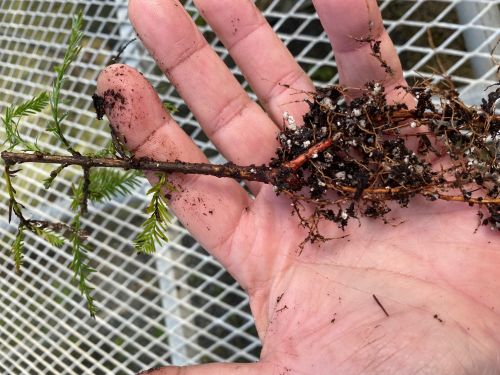
T406 Cutting
The breeding program in China can be summarized as controlled cross and open pollinated seedlings grown out in large fields at close spacing (about 6” to 1’ apart in rows 4’ apart is typical).
After the first year, they are then cut off near the ground. That last step results in upright shoots and the strongest leader is favored. They usually grow 4-5 feet in the second year and selections are made then. The selections are propagated by cuttings, rooted, planted out and then allowed to grow to provide a foundation for cutting generation. Four to six-inch cuttings in June with an overnight hormone dip is a typical strategy in China. Young seedlings provide wood that typically root quite well. Cutting wood from old trees root poorly or not at all. One strategy is to cut the trees back severely all the way to the trunk which generates plenty of vigorous growth. Thick, robust green cuttings root better than thin twiggy wood. From my experience, the key to success depends more on the actual age of the clone and the nature of the cutting wood than hormones. Because they are cutting grown, the resultant plants typically exhibit plagiotropic growth (growing more or less divergent from the vertical, also referred to as topophysis. That is they tend to be “branch-like” and don’t form a leader unless pruned and trained. Upright growing shoots, however, begat upright growing trees.
Out of a about a dozen advanced selections from China, one BC X MC clone has emerged that is superior simply because it is quite free of needle blight, Cercosporidium sequoia. It was tested as T406 and with Nanjing Botanical Garden’s permission, we named it ‘LaNana” after the creek that traverses this university (Creech 2017). In our region of Texas and all the way across the Gulf South, Montezuma cypress can be affected by needle blight (McDonald et.al. 2008). ‘LaNana’ has proven to be highly resistant in our cooperator plots while other selections can be quite dramatically impacted, some years worse than others. For instance, we have another clone (T502, named ‘Banita’) which is almost evergreen in most winters, keeping old needles until the new growth emerges in March, the degree of needle drop depending on the severity of hard freezes. The term for foliage retention long into the winter is marcescent. ‘Banita’ is very fast growing and features light green foliage but lacks resistance to needle blight in some of our test locations in the humid Gulf South. However, in central Texas and parts west, it appears free of the malady.
One final question has been answered. After winter storm Uri in mid-February 2021, we can report that all of our Taxodium collection came through without any damage. With an all-time record low of -3oF in Nacogdoches, we now have a benchmark for hardiness. Since none of the hybrids have ever experienced such a low temperature, this was a great test and we now have the promise of a more northern range limit. The December 1983 and 1989 freezes and the February 2021 freeze provided hard evidence that even straight MC is surprisingly hardy.
If you are interested in trialing the hybrid bald cypress, we suggest you make a trip to the Pineywoods of Texas. We’ll give you a fine windshield tour of the collection and if we have them on hand in small sizes, we do love to share. Let’s keep planting.
Red River Wildlife Refuge
LITERATURE CITED
Robert Adams, Mike Arnold, Andrew King, Geoffrey Denny, David Creech. 2012. Taxodium (Cupressaceae): One, Two or Three Species? Evidence from DNA Sequences and Terpenoids. Phytologia 94 (2): 159 – 168.
Arnold, M. and G. Denny. 2007. Taxonomy and Nomenclature of Baldcypress, Pondcypress, and Montezuma Cypress: One, Two, or Three Species? HortTechnology 17 (1): 125-127.
David Creech. 2017. Taxodium X ‘LaNana’ – Born in America and Mexico, Improved in China.
Tags:
Learn
Permalink
|
|
|
Posted By Admin,
Friday, June 9, 2023
|
The Miracle Mile, Part 2
By Leah Alcyon
November 2, 2020
Two Juniperus occidentalis (Western juniper) are visible behind the author
In October of 2016, I backpacked with my husband into Little Duck Lake in Northern California and spent three days “ticking” 17 species of conifers that grow in a richly diverse square mile of high granite mountain terrain. I wrote about that experience in the ConiferQuarterly with an outline of the history of the “miracle mile” and the process of finding all of the species in that area. One extra species was known at that time, and although the coordinates were not available, we made an attempt to find it anyway. The area in question is steep slab granite that is accessed from a valley where thick brush makes climbing difficult. We hiked up the trail to Sugar Lake and poked around for an afternoon on and near the slab granite but we did not have the right stuff for success.
Fast forward a few years and we now have a new formula for success. First, Calypso our 10 year old Shar-pei/Shepard joined in the adventure as she is a hiker and conifer connoisseur. Looking for one Juniperus occidentalis among the myriad Douglas squirrels and chipmunks was right up her alley. After the fires and smoke in the area finally cleare, it seemed an auspicious time for some late season hiking. The real key for success, however, was Michael Kauffmann’s update to the website for his book, Conifer Country, which now included the latitude and longitude of the western juniper! Not that we aren’t intrepid hikers fond of cross country bushwhacking, but there is a psychological energy necessary to scour the mountains off-trail for trees rather than stroll on a trail to a known site. Richard Moore, a local from Callahan, had been hiking in the area since the 1980’s and knew about the pocket of western junipers on the Sugar Creek drainage. He connected with Kauffmann after Conifer Country was published. It is one thing to be an intrepid hiker, but quite another to know an area like the back of your hand and be able to identify plants and trees that might be unusual. A good analogy is bird watching, where it’s great fun to get a report of a rare bird and go chase it, but quite another matter to be the one to spot it in the first place.
So although we were not going to be the discoverer of the junipers in this area, it was challenging enough to scramble through the brush and climb the steep granite cliffs in search of this elusive tree. Western juniper usually occurs on dry, rocky sites where there is less competition from larger species and, true to form, this is where we found them. There must be 20 individuals along fault lines going upwards from 6000 ft elevation to the ridge at 7000 feet. Each tree had a different look; some were straight and some were buckled and krummolzed. The one that was lowest down was in the shade of a pine and very small. Finally, even though we needed the GPS coordinates, it was exhilarating to make it to the wall and see numerous juniper trees, lined up with the gravity fall of their berries down seams in the granite.
And the berries on the junipers are so numerous this year that there were a number of trees that looked like grape vines, they were so laden with purple fruit.

No, we're not making wine, we're making gin!
Townsend’s solitaires, Clark’s nutcrackers, and varied thrush were in abundance around the trees. The biggest surprise was a frog – sitting on the granite at 6,000 feet! It appears to be a Cascade frog, Rana cascadae.
Rana cascadae, basking in the sun at high altitude
After taking photos of the different shaped trees and the masses of berries, we headed back to the main trail. Calypso, with her four-paw drive, had easily accompanied us up the trail and up onto the granite. But it was clear that going down was not as easy as going up, even for her.
As for the evolution of the miracle square mile, we noted that the boundaries have been shifted slightly from the first iteration to a new area, which now includes the western juniper above Sugar Creek. Sugar Creek and the lake are also highly diverse conifer environments and very accessible. While chilling out in the one and only camp site at Sugar Lake, I was able to quickly find seven species of conifers. Several more were within a short distance of this area. On the hike out we scanned the granite wall for the junipers with binoculars and found them clinging to the vertical wall for dear life!
Nature made some beautiful sculptures in the Miracle Mile
A list of conifers within the Miracle Mile:
Tags:
Learn
Permalink
|
|
|
Posted By Admin,
Friday, June 9, 2023
|
Spring Flush (Conifer Style)
By Web Editor
May 7, 2021
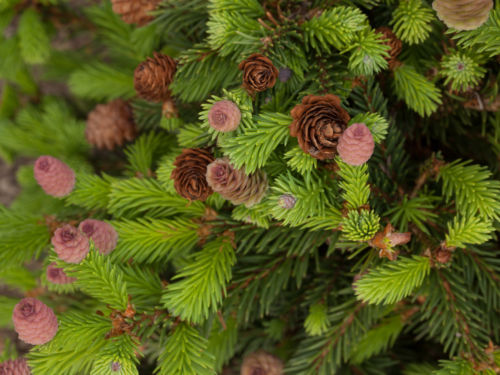
Picea abies 'Pusch', looking like a rosebush in bloom! Photo by Janice LeCocq
Spring is here, and it's not just about flowers. Conifers have both showy new growth and gorgeous cones. Some will rival even the most flamboyant flowers. Take the Pusch Norway Spruce above, for example. And those 'roses', which are actually seed cones, don't need to be deadheaded and persist for weeks.
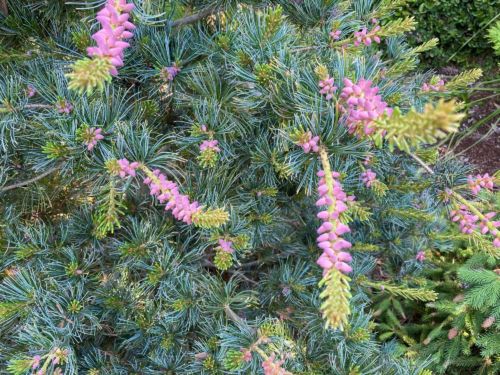
Pollen cones on Pinus parviflora 'Cleary'
Male (pollen) cones can be showy, also, as the Cleary Japanese white pine above illustrates. Pinus parviflora is a much-prized species, due to its soft needles, often borne in two-toned clusters and in some cases with yellow, white or pink new growth.
Known familiarly as 'Goldylocks', this Japanese white pine sports lemon-yellow foliage in spring.
Pinus parviflora 'Tenysu kazu', also known as Goldylocks, is one of the showiest conifers in spring. It's pretty nice the rest of the year, too, with its slightly twisted needles that have silvery undertones. This one appears to be harder to grow than many other white pines, but the beauty may be worth the potential heartache!
Close up of Pinus parviflora Goldylocks new spring foliage
Picea pungens (Colorado spruce) 'Maigold'
Picea pungens 'Gebelle's Golden Spring'. Photo by Janice LeCocq
Several Picea pungens also have ruby-colored cones.
Picea pungens 'Ruby Teardrops' is probably the best-known spruce for jewel-like new cones. Pictured above is Picea pungens 'Koster Pendula', not a legitimate name but found fairly often in the trade so styled.
Taxus baccata 'Bright Gold' puts on a show in spring.
Taxus baccata 'Dwarf Bright Gold' has new foliage the same color as Forsythia flowers, but the Taxus, commonly called English yew, rarely needs pruning. Even better, after the spring flush has subsided, it contributes color, structure and depth to the garden.
What's happening in your conifer garden? Colorful new growth? Interesting cones? We want to see your photos!
Tags:
Learn
Permalink
|
|
|
Posted By Admin,
Friday, June 9, 2023
|
Touring with Talon: Buchholz & Buchholz Up Close and Personal
By Sara Malone
March 9, 2013
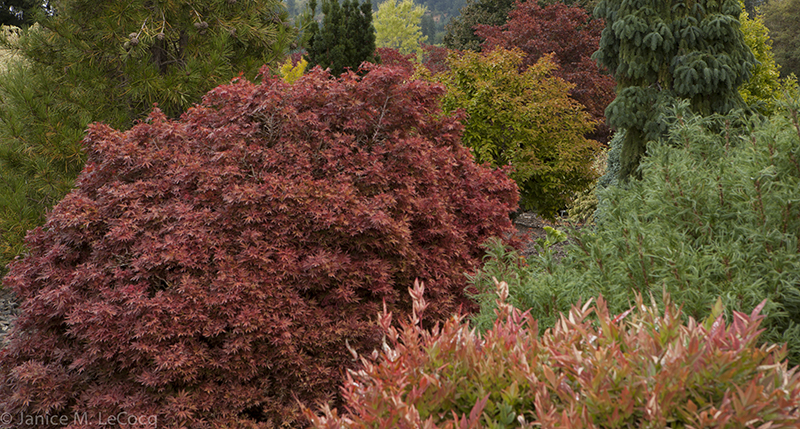
evergreen plants, conifers, foliage plants
When we set out to tour the iconic nurseries of the Pacific Northwest, we confess to having been a bit nervous that they would not live up to the folklore that has been created and nurtured by the conifer cognoscenti. Our third stop, Buchholz & Buchholz, continued the theme of exceeding our expectations! Talon Buchholz, whose eponymous nursery is responsible for almost as many plant introductions as the Garden of Eden, met us upon our arrival and gave us a personal tour. His affection for the plants and their histories made this one of our favorite stops on our road trip.
conifers, evergreen plants, Buchholz & Buchholz
Talon's nursery includes a wonderful, quasi-naturalized display garden, the Flora Wonder Arboretum, which exudes more personality than most commercial settings. A number of the plantings have clearly been in the ground for many years, and elements of whimsy and creativity abound. Conifers, maples and other woody specimen plants are Buchholz's specialty, which is one of the reasons that we were eager to visit.
Weeping larch
It's clear that Talon has a sense of humor; the weeping larch in the above photo looks like some kind of mythical creature and there is even a weeping Douglas fir that has been pruned in the shape of an elephant. The interplantings of conifers, maples and other deciduous specimen trees and shrubs is both artful and natural. There is no pretension here--the plants speak for themselves.
conifers, evergreens, foliage plants
It was a joy to see specimens in the ground, obviously carefully placed and planted. Talon knows each plant--each specimen, actually--and tells the story of how it came to be - and be included in the Buchholz & Buchholz repertory. His nursery covers many, many acres and yet he speaks of the plantings with more personal connection than do most gardeners with infinitesimally smaller lots.
Japanese maples at Buchholz & Buchholz
The Japanese maples in the gardens were amazing--a wild array of colors, shapes and textures. It was instructive to see so many mature specimens in the ground; so often we are reduced to seeing small plants in pots or recent garden plantings. The maples were beginning to take on fall color when we visited, we can only imagine what they look like in spring with new growth. mixed foliage, evergreen shrubs, conifers
As the border above illustrates, the Flora Wonder Arboretum is an homage to the concepts of form and foliage; Talon interplants conifers, maples, ginkgos, natives and grasses with an easy hand. The plants are given enough space to demonstrate their shapes and architectures.
Ginkgo biloba, Buchholz & Buchholz
Many of the Flora Wonder plantings have been in the ground for decades - it is a great spot to see specimens that have attained some size, such as this Ginkgo.
maples in containers, Buchholz & Buchholz
The greenhouses abound with specimen plantings beautifully displayed in cedar boxes - Japanese maples, conifers, etc were arrayed in soldierly rows. We were particularly taken with the pumice planters, in which single plants or combinations were attractively nestled. It was at about this point that we tried to figure out if they would fit in our luggage.
Weeping purple beech, fagus sylvatica 'Purpurea Pendula'
We thoroughly enjoyed our visit and took our leave only because the staff was trying to close for the day. Talon's website has hundreds of beautiful images and if our review of our visit piqued your interest, go on a virtual tour with Talon at Buchholz & Buchholz Nursery. You won't be disappointed! Next stop: The Oregon Garden's Conifer Collection, Silverton, OR
Tags:
Learn
Permalink
|
|
|
Posted By Admin,
Friday, June 9, 2023
|
Taxodium Species Finally Get Some Respect!
By Frank Goodhart
September 5, 2020
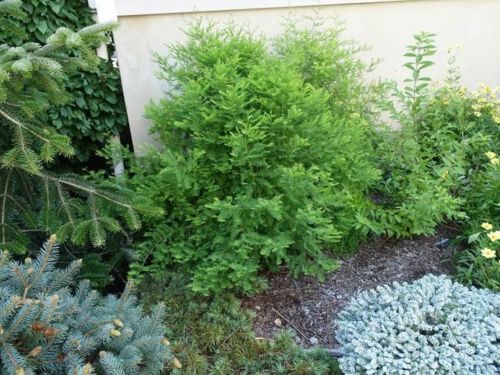
Taxodium ascendens cluster made from three trees that are cut back each year. Other plants from left to right are Carpinus betulus 'Nana', Abies nordmanniana ‘Pendula’, Picea pungens ‘Hermann Naue’, Cedrus libani ‘Hedgehog’, Abies koreana ‘Ice Breaker’, Callicarpa dichotoma ‘Issai’, and Coreopsis verticillata ‘Moonbeam’.
Bald and pond cypresses are versatile trees for the landscape, so why don’t they get planted more? Sometimes Taxodium species are not considered to be suitable for northern landscapes. This is perhaps due to northern visitors seeing them at Cypress Gardens in South Carolina or the Everglades in Florida and then presuming that they are not cold hardy. But the nativity of bald cypress extends into the colder areas of the U.S., such as southern Illinois and Missouri. They have even been successfully grown in colder zone 5 areas in the Midwest and New York State. Pond cypress is a bit less hardy but certainly is a zone 6 tree. The ACS lists both bald cypress (Taxodium distichum) and pond cypress (Taxodium ascendens) hardy to zone 5. (Author’s note: there is a third species in this genus, Taxodium mucronatum, but it is a semi-tropical, zone 9 plant.)
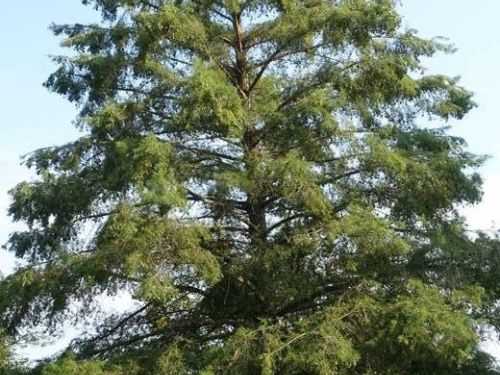
Summer profile of Taxodium distichum at Frelinghuysen Arboretum, Morristown, NJ
Taxodium are among the few trees that are notably resistant to most insect and disease problems. They also are very resistant to blow-over by high winds, a feature that is now more important in times of major changes in the weather.
Cultivars of T. distichum include ‘Pendens’ which has large cones and drooping branchlets, ‘Shawnee Brave’, a narrow pyramidal form, and ‘Monarch of Illinois’ which is wide spreading. There is also a dwarf selection, found by Gary Gee of Gee Farms in MIchigan, called 'Gee Whizz'. Read the link to see why Gary gave it this name!
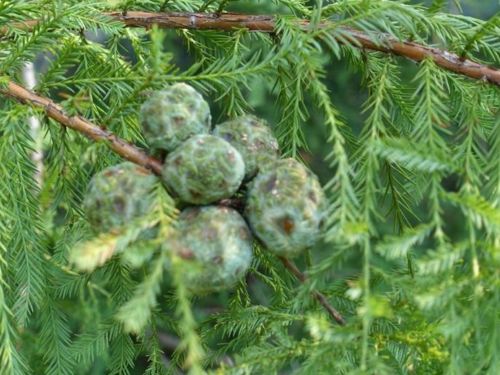
Seed cones of Taxodium distichum at Frelinghuysen Arboretum, Morristown, NJ
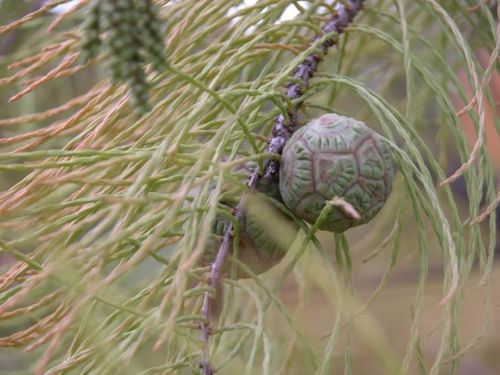
Taxodium ascendens seed cone on the cultivar ‘Nutans’ showing a tinge of pink color and interesting geometric pattern. The cone is slightly ovoid.
Bald cypress and dawn redwood (Metasequoia glyptostroboides) have a similar overall appearance, as both are in Cupressaceae, the cypress family. Their macro-appearance is similar, but they can be distinguished by noting whether the leaves and branches are alternate or opposite. Bald cypress has alternately arranged leaves and branches, often referred to is the ‘ABC rule”: alternate bald cypress. Dawn redwood is much more frequently used in the landscape than bald cypress, perhaps because of the fascinating story of its finding in China in the early 1940’s, long after it was thought to be extinct. Following this discovery, a large amount of seed was exported to the U.S. and Europe and trees were grown in arboreta and large estates across both the old and new worlds. It rapidly found its way into the landscape industry because of widespread adaptability to American gardens.
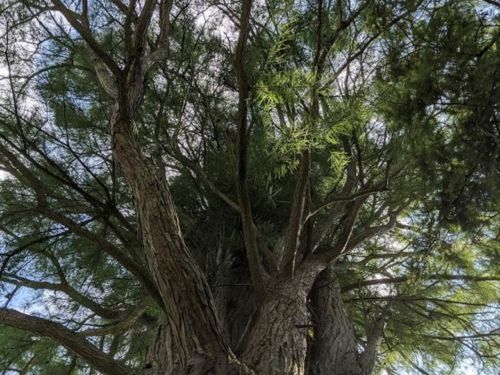
Taxodium ascendens ‘Morris’ (Debonair®) original plant at Morris Arboretum of the University of Pennsylvania, Philadelphia PA.
Meanwhile, the bald cypress was viewed as a utility tree, that had wide usage across the Southeast, where there are large native stands. It was the ‘go to’ tree if one had a need for a decay resistant wood for outdoor use. The wood is stable and easily worked and still is available in southern states for building purposes. Logs that have been under water for a long time are called sinkers. They are brought up from the bottoms of streams and rivers and processed to produce particularly beautiful boards and trim for the building industry.
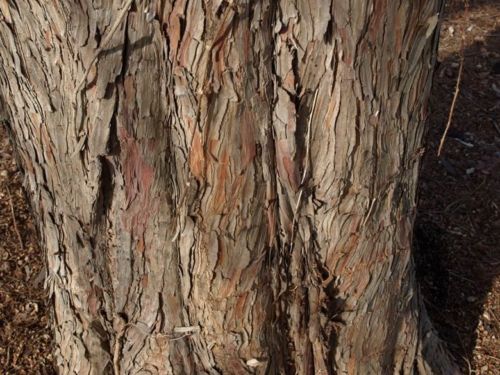
Taxodium distichum bark of an older tree.
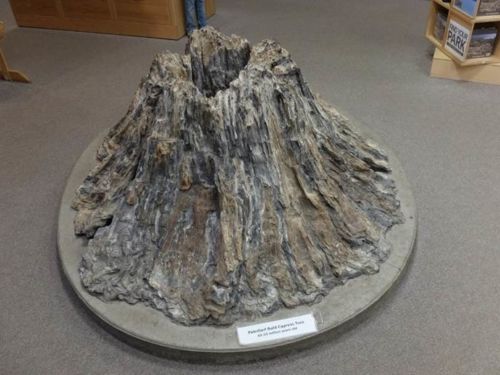
Taxodium distichum fossilized buttress found at Theodore Roosevelt National Park in North Dakota, age 65 -53 million years.
While often used as landscape trees in the southern states, it seems that neither bald nor pond cypresses were considered much for use in the northern states. This may be due to the misconception that they are not cold hardy. This is now changing because of the discovery and use of cultivars in recent years. Among the ornamental features that add interest are fastigiate and weeping types as well as those having appressed leaves and intermediate and slow growth rates.
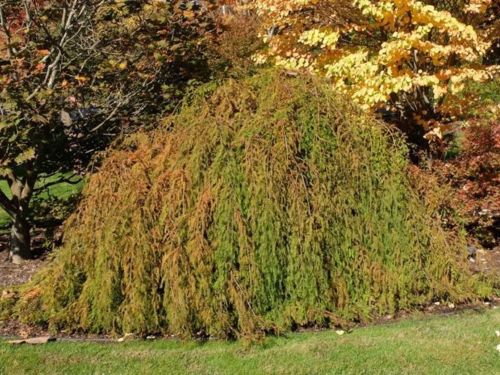
Taxodium distichum ‘Cascade ‘Falls’ in October – This now popular form was named, patented, and distributed by Noeline and David Sampson, Cedar Lodge Nursery, New Zealand.
Bald cypress typically reaches a height of 50 to 70 feet and a width of 20 to 30 feet. Pond cypress is the junior tree to bald cypress as it grows more slowly but may eventually reach the same height, although it is narrower. Bald cypresses can grow in wet areas but are adaptable to places having normal rainfall. Traditionally, they have been planted next to ponds, allowing development of ‘knees’, vertical woody projections that emanate from the roots and appear around the trees (see photo). Pond cypress in its native habitat grows on higher ground than Baldcypress but is also capable of growing knees if the soil is moist. Neither tree will form knees in areas having only average rainfall. The reason that cypress form these structures on their roots is unknown. The leaves of the pond cypress are shorter and slenderer than those of the bald cypress and are in general angled upward, giving it a distinctive appearance.
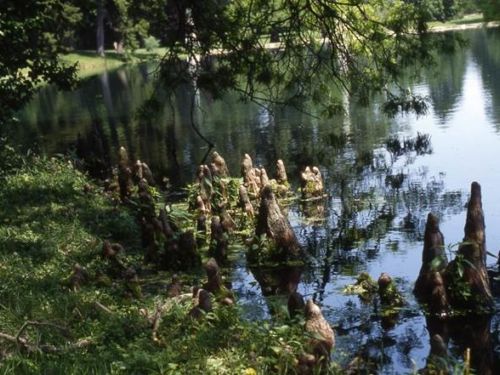
Knees form on both bald cypress and pond cypress
All Taxodium species are deciduous, and in most climates turn a fiery orange in autumn, another wonderful reason to include one in your landscape!
Row of Taxodium ascendens ’Nutans at the Presbyterian Church cemetery, Morristown, NJ showing ‘straw’ consisting of fallen leaves and branch tips at the season’s end.
Taxodium ascendens ’Nutans’ on the upper pond bank at Frelinghuysen Arboretum, Morristown, NJ in October.
Taxodium distichum – Typical seed, leaf, and twig drop seen in January at the Frelinghuysen Arboretum.
Taxodium disticum bark of a younger tree not planted in a wet location. Note the orange color and the slightly flaking bark.
Seedlings of Taxodium ascendens in July from seeds collected in January and stratified for 10 weeks. Cones can be collected off the ground in the December – January timeframe in Morristown, NJ. On aging the cores will shatter making it easier to obtain the seeds.
Taxodium ascendens ‘Morris’ (Debonair®) showing appressed leaves. Original plant at Morris Arboretum of the University of Pennsylvania, Philadelphia PA.
Winter profile of a Taxodium distichum at Frelinghuysen Arboretum, Morristown, NJ
Winter profile of a Taxodium distichum at Frelinghuysen Arboretum, Morristown, NJ
Cones of Taxodium distichum in mid-winter, Frelinghuysen Arboretum, Morristown, NJ.
Have you thought of growing a Taxodium? Or maybe you already have one. Post photos and questions in the comments!
All photography by Frank Goodhart.
Tags:
Learn
Permalink
|
|
|
Posted By Admin,
Friday, June 9, 2023
|
The Color Purple
June 20, 2016
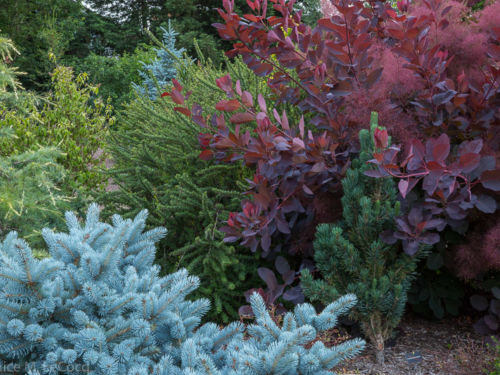
In spring the go-to colors are pastels, and the foliage garden certainly has its share of baby blues and soft yellows. However, they often share the garden space with deep, grown-up purple, which contrasts richly with the softer hues. Colorado blue spruce cultivars (Picea pungens cv.) are the quintessential powder blue foliage plants. When paired with other pastels, they have a demure persona, belying the strength inherent in their tough, spiky needles. Around purple, however, the blue acquires a steely note.
Picea pungens 'Lucretia' against Cotinus
Purple works well as a background color, especially if you want the background to be, well, in back. Lighter colors draw the eye, darker ones recede. A purple background allows the plants in front to claim the attention.
Eucalyptus pulverulenta 'Baby Blue' against the purply Cotinus
The Eucalyptus in the shot above is about as pastel as it gets, yet takes on a more sophisticated mien when backed by smoky Cotinus x 'Grace'.
Cercis canadensis 'Forest Pansy' is a lovely, if somewhat awkwardly shaped, small tree. Here it is planted behind a grouping of different shades of blues and greens and serves as a backdrop which adds richness to the scene and disguises its lanky branching.
Picea pungens 'Stoplight' and Mangave 'Macho Mocha'.
Succulents are a good place to look for 'evergreen' purples; the Mangave above is another great companion for blue spruce. Not only do the colors provide fabulous contrast but the strappy leaves of the Mangave are a wonderful foil for the spruce's small needles. And in true F&F fashion, these plants do the job all 12 months of the year.
A richly hued combination of purple Sedum, yellow Chamaecyparis
Chaenomeles, Cotinus x 'Grace' and Juniperus conferta
For a stained glass effect, mix purple with other saturated tones such as the greens and yellows pictured above. Paired with the yellow the purple warms up and creates deep contrast to the other colors.
This Cordyline
There are many grass-like plants (and even some true grasses) that add purple to the garden. The Cordyline 'Design-a-Line Burgundy' in the photo above adds depth and flair to what would otherwise be a colorful but flat combination, and, like the Libertia peregrinans (the orange grass) and the blue spruce and holly, holds its leaves all year. Many Phormium come in shades of purple and for those that don't mind the maintenance, there are several Pennisetum cultivars in deep purple tones.
Leptospermum 'Dark Shadows', Cotinus x 'Gracel and Cordyline
Colors work best when they are not isolated; don't hesitate to echo the tones throughout the garden. If you look carefully at the above photo you will also see a bit of purple in the far back about 3/4 of the way across the photo, as well as some purple tones on the plant in the immediate middle front.
Sambucus nigra
Apparently the colors 'Blue' and 'Black' sell better than the color purple. There are many plants sold as blue or black that are really purple, such as the Sambucus (elderberry) above. Remember, when selecting your plants, go by what the foliage looks like, not what the label promises. This Sambucus is deep wine-purple, and can be grown as a large shrub or limbed up to make a small tree.
Picea pungens 'Fastigata' and Coprosma
Purple gets more subtle in plants with two-toned leaves like the 'Plum Hussey' mirror plant. This cultivar of the New Zealand Coprosma leafs out bright green and the older leaves take on purple-tinged edges until the cold weather comes and drenches them in a deep, plummy coat. You can see Cotinus x 'Grace' in the background, striking, as befitting, a grace note. We can't seem to stop pairing our purples with light blue, can we?
The Cordyline
The genus Fagus, or beech, is another good place to go purple-hunting. In the shot above the tones of the large Cordyline in the back are picked up and carried forward by the glossy purple beech. The Yucca 'Blue Boy' (really purple, but that didn't make for the alliterative name) in the lower right hand corner continues the theme.
Yucca desmetiana
Fagus sylvatica
Beech trees (Fagus sp.) are welcome additions to gardens that are climate-appropriate because of not only their beautifully colored and textured leaves--at once both glossy and fuzzy--but also their elegant, silky bark which graces the winter landscape. They do best in spots with ample rainfall but once established will manage fine in even mild Mediterranean climates with little more water than some of the drought-hardy standbys.
Podocarps elongates 'Monmal' (Icee Blue) is flanked by Hebe
Purple doesn't have to be bold or strident; there are many plants with purple leaf edges or undersides, like Hebe 'Amy' in the photo above. 'Amy' also has purple flowers, but they are ephemeral. The leaves and stems are purple all year long.
Abies x arnoldiana
For real subtlety, treat purple as an ornament, the way that one might wear an amethyst ring or a garnet brooch. The cones on the 'Poulsen' fir are luscious, deep purple and decorate the shrub for months in spring and early summer.
Get your purple on!
Tags:
Learn
Permalink
|
|
 ACS President
ACS President SER President
SER President CR Director
CR Director WR President
WR President ACS Secretary
ACS Secretary SER Director
SER Director WR Director
WR Director CR President
CR President ACS Treasurer
ACS Treasurer